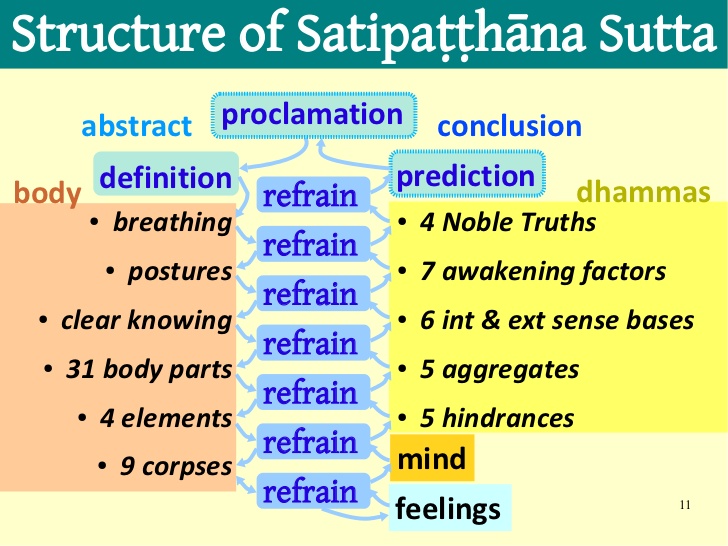Satipatthana is a Pali term that implies the establishment or foundation of mindfulness. Right Mindfulness is also known as ‘Sammasati’ in Pali language while ‘Samyak Smriti’ in Sanskrit. Right Mindfulness means to maintain focus on every aspect inside and outside yourself in this present moment. In the great teachings of Buddhism, right mind-fullness is its heart.

Right Mindfulness is not a theoretical and classical education, but it paves the way to live a practical life. Right Mindfulness not only gives freedom from sorrows but also leads to the experience of the ultimate truth. The perfect mind-fullness was a key means in helping Lord Buddha to experience the ultimate truth.
Satipatthana Sutta
Right mind-fullness is a process that can be developed through practice. In this process, practice begins with observing the breath. In this process, life is lived being awakened in the present moment where there is freedom from the past and future. There is no anger, repentance, fear, forgetfulness, etc. in this present moment. Every moment of life has to be lived without any bias, prejudice, attachment, imagination, etc.

When a person is free from all these impurities and sees anything in its original form, then he becomes the master of himself rather than his mind. Because of these impurities, the mind shows things as unrealistic and due to this, the mind retains dominance over a human being. If there is a domination of the mind, then the mind becomes the master and keeps languishing human being in sorrow and pain throughout life. In the observance of right mindfulness, there is the importance of four important elements -the body, the vedana, the citta, and the dhamma.
Kayanupassana
The process of mindfulness begins with a focus on this body ie Kaya. Spiritual achievement of life is also associated with this body. Starts with observing your breath. The breath is true, no imagination attached with it. Breath is bare present where there is neither past nor any future entities attached with. After this breath, attention is given to the different postures of the body. Walking, sitting, eating, lying down – one has to maintain observations in all the postures.

Any physical activity of life should be done consciously and not in an unconscious way. Walking, speaking, eating, drinking, watching, bowing, sleeping – in all these actions consciousness has to be maintained. Along with the body, there must be awareness of its impermanence nature and unattractiveness. Yogis and seekers find this body as impermanent and take cognizance of the entire body in its pieces as unattractive, although ordinary people take time to be free from it.
Vedananupassana
Here, ‘vedana’ means paying attention to the thoughts, sensations arising within the mind. A series of thoughts go on the screen of the mind. Just like the infinite and continuous waves over the infinite ocean. Thoughts over thoughts. One thought did not end, another thought arises. The second thought was not finished, the third thought arises. An endless series of thoughts emerge and get an end.

Our mind experiences thoughts mainly in three ways – pleasant thoughts, unpleasant thoughts, and neutral means neither pleasant nor unpleasant thoughts. In the experience of thoughts, it has to be maintained that there is no attachment of ‘I’ or ‘mine’ in any kind of thought. Whether the idea is pleasant or unpleasant the practitioner has to observe being vigil and conscious. It is not that one starts dancing in pleasant thoughts while starts crying in unpleasant thoughts. Isolated from thoughts, it is being practiced as mere observing the emerging and fading away of clouds from the infinite blue sky.
Cittanupassana
The mind is known as ‘Citta’ under general reference. Though at the spiritual or subtle level, mind and citta are not equal, a difference exists. Citta has its own inherent properties, in which there exhibit impurities. Craving, malice, anger, attachment, etc. are prominent among the impurities of the mind. Consciousness has to be maintained here too. If there is anger inside the mind, it is to be aware that there is ‘anger’.

However, this is not a simple task. If there is a craving or raga for something in the mind, it is necessary to maintain consciousness here that there is a ‘raga’. If the mind is skeptical or confident, fragmented or dis-fragmented, decentralized or focused, enthusiasm or excitement – whatever kind of moment, the seeker has to observe it consciously. Here too, in the condition of the mind, one has to be separate from any kind of attachment like ‘I’ and ‘mine’ and observe it consciously.
Dhammanupassna
Here ‘Dhamma’ means two forms – first mental factors and the second intellectual teachings. The function of the mental factor serves to color the state of the mind. Mainly there are ten skilled mental factors, such as – Sraddha, Advesh, Alobha, Upekcha, Ahimsa, etc. In the same way, unskilled mental factors include Moha, Asradha, Pramad, etc.

The second form of Dhamma here includes five obstacles, five aggregates, six internal and external bases, seven factors of Enlightenment, and the Great Four Noble Truths. Dhammanupassana refers to the contemplation of phenomena. Dhymanupassana is a comprehensive concept under right mindfulness, in which awareness and consciousness have to be maintained while practicing.
courtesy : Google images





